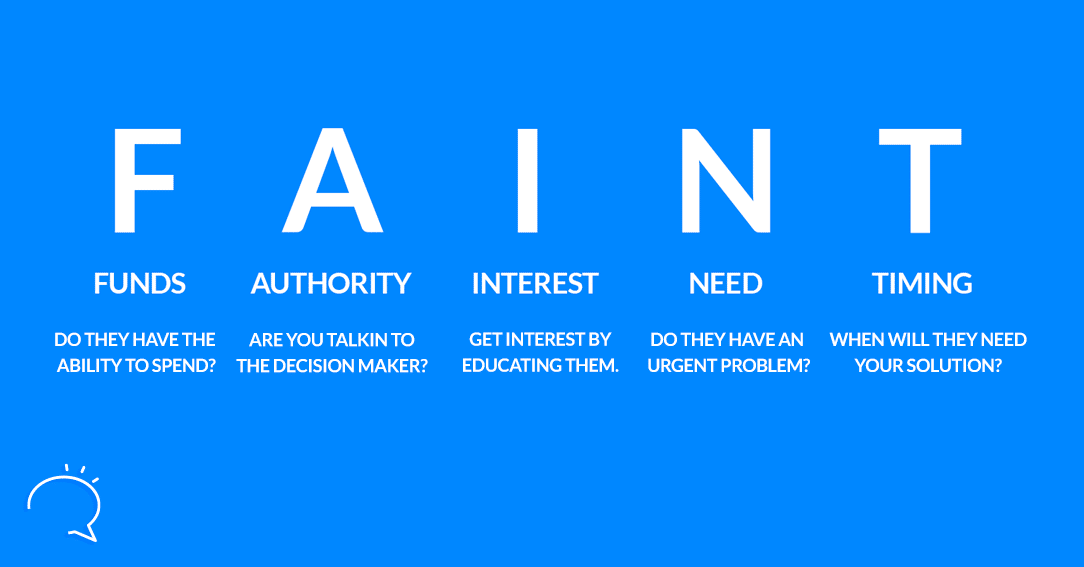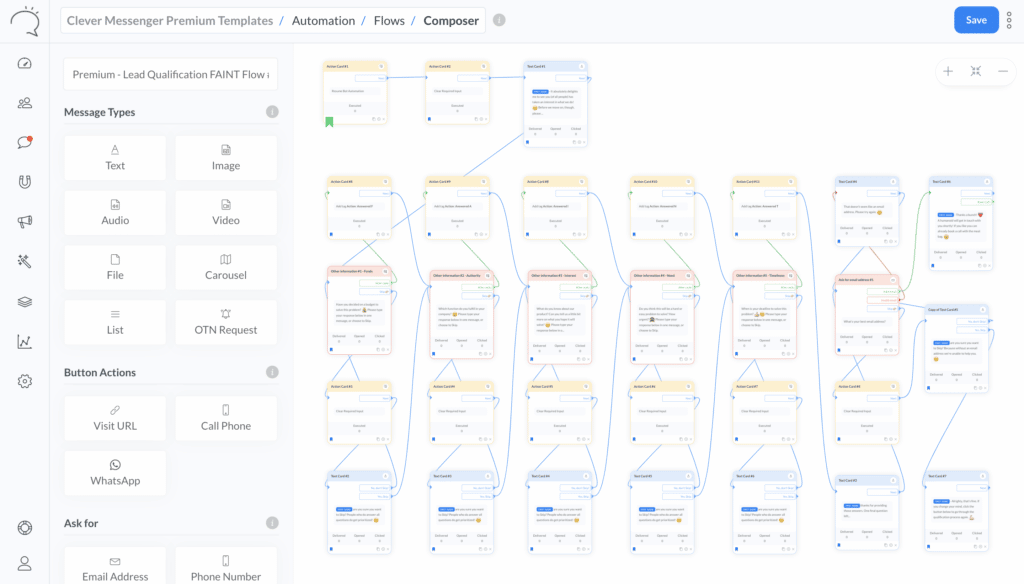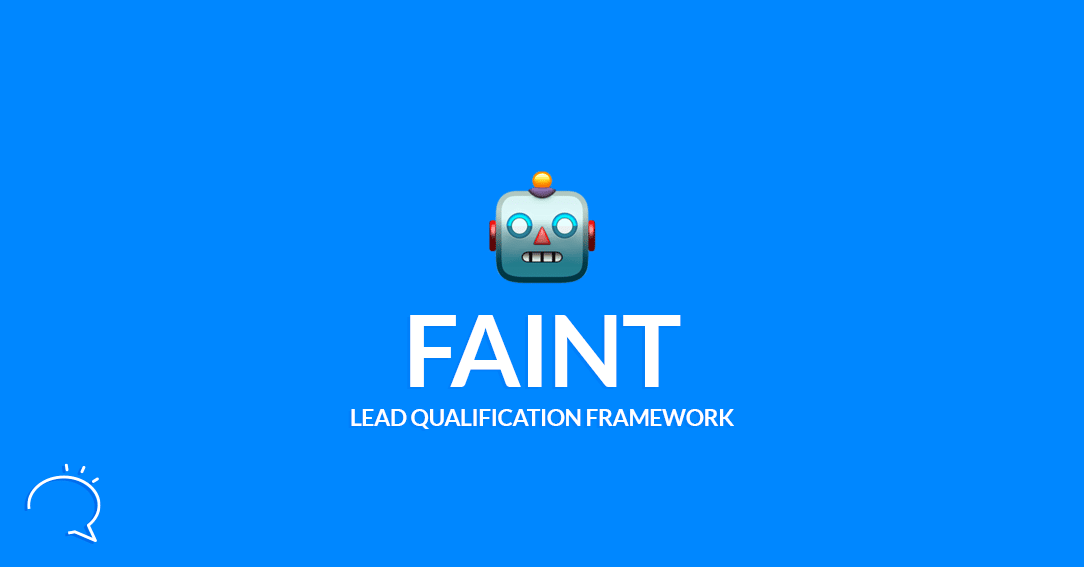Wondering what the FAINT lead qualification framework is about? Well, there’s no doubt about it. Only a few businesses know what the FAINT framework is all about. Let alone how to integrate such a framework into their business model. And to top that, Chatbots are the future of sales and lead generation. But only a few people know how to optimize them or use them “the right way” for business growth.
Unfortunately, this gap in understanding is resulting in businesses generating fewer good leads. They could be generating more and way better leads if you combine them together!
We want to bridge that gap. That’s why we’ve written this thorough piece on what precisely the FAINT sales framework is. We’re going to delve deep into each of the five principles of the process to define FAINT. But, not only that! We’re then going to let you know exactly how a chatbot can further help with this strategy in your business.
FAINT: What Does it Mean?
First, we’re going to dig into what exactly FAINT is. As a sales and lead qualification framework, FAINT works like other sales frameworks. Other frameworks include BANT, MEDDICC, and much more. In this respect, it offers a step-by-step process of understanding in sales generation. By using FAINT, you cannot just secure sales but secure the right kind of sales that your company needs.

The FAINT Lead Qualification Framework Explained
FAINT refers to the following model when defined:
- F – Funds in reference to the customer’s funds and how highly they should be prioritized as a result.
- A – Authority in reference to how much power the individual you’re dealing with has over a purchase.
- I – Interest in reference to how much interest they’re showing in your product. Plus, how this can be leveraged.
- N – Needs in reference to the market needs of the person or business you are dealing with.
- T – Timing in reference to the timeframe in which the person you’re dealing with will become a purchaser.
Cool. You now know the basic definition, but let’s go into greater detail. Let’s dive in and see what each of these individual definitions means for the framework as a whole. Ready?
F – Funds
Funds are a significant way in which FAINT differs from the BANT model. In BANT, the B stands for “Budget”. The B in BANT concerns the amount of budget a company or individual has to spend on your product or service. In BANT, if this person doesn’t have enough of a budget, they are immediately discredited. With FAINT, the concept of Funds is looser. See, FAINT understands that just because a company has an allocated budget… it isn’t the be-all and end-all of their purchasing power. With “Funds”, the budget itself is considered, but alongside other factors too. Factors like the size of the company you’re dealing with. Or, the financial profile of the company, if you can find this information out.
So, in the first stage in the framework, you identify the Funds available to the potential buyer. Mainly you need to find out that they can afford your service or product, but also, crucially, by how much. If they have more to pay for than what you’re offering, you can look at add-ons or extensions. If they don’t quite have enough, you know to focus on the basic offering.
A – Authority
Authority is the next stage in the sales process and exists to ensure you’re talking to the right person. There’s no point giving an hour-long sales pitch to a Support Staff member who has no authority over agreeing to the sale. This can be figured out early on through a simple question, or some background research. If you don’t complete this step, you can waste a great deal of time and money. And you definitely don’t want that.
I – Interest
This is the real ‘sales pitch’ part of the FAINT sales framework. Once you know how much they can spend and are authorized to spend it… you need to sell this person on your product or service. You should generate interest and win your audience by clearly defining your offering. How superior is it to others on the market, or how unique the offer is you’re putting on the table. Rule of thumb is that without generating enough interest… you’ll never succeed in closing the deal. This is the stage with arguably the most leeway. Because this is where you adapt your own sales approach… as long as it’s based around generating suitable interest in what you’re selling.
N – Need
“Need” exists in many other sales frameworks. With FAINT, it serves much the same purpose as it does in BANT. Namely, it is about recognizing the ways a potential purchaser needs your product. To do so, it’s good to research on the goals of a company or individual and relate this to your product or service. It’s about asking about problems, then providing the solution. Testimonials or other evidence can further show that you’re the right company for the job.
T – Timing
Timing is another way in which FAINT provides a more comprehensive framework. Many other frameworks end with need, but FAINT takes into account how long it can take to make purchases. With Timing, you need to get the purchaser to agree on when to make this purchase, be it immediately or in the future. This can show how in-demand they are for the service and can affect future negotiations. Conversely, if there’s little interest shown, then you can delay the sale or disqualify the potential sale outright.
Why FAINT Works
As you can see, FAINT works because it’s a more elaborate framework than some of the others adopted by businesses today. It factors in the funding of a purchaser as well as the timing of the sale. But it also keeps the essential aspects of a robust sales framework, in Authority, Interest, and Need. When implemented the right way… a lead qualification framework like FAINT ensures you’re not wasting time. Above all, you don’t really want to try to generate sales that will never happen, right? With FAINT, you get essential information up front. And with this info, you’ll know if it’s worth investing in the sales opportunity. It also allows you to build a hierarchy of your sales. For clients with more funding, you can find this out immediately and work harder as a result.
All in all, it means FAINT creates a higher level of accuracy in qualifying leads. This can then affect sales forecasts positively, which can then be used to optimize sales initiatives in the future as well. And that’s what we call a Double Whammy, lol. Great, right? But, I hear you thinking: “How do chatbots fit within this lead qualification framework?” … Well, let’s continue!
Using Chatbots In a FAINT Sales Framework Strategy
Chatbots are an excellent way of automating sales strategies. Because of this, they can be seamlessly integrated into a FAINT strategy for any business. You can program your chatbot to ask key questions of purchasers early in the conversation. These questions can quickly help you find out the funding potential of a customer. As well as the authority they hold over making the purchase themselves. See? This already handles 2 aspects of the sales framework before dedicating any employee time to the negotiation. A chatbot can then effortlessly connect a purchaser to a sales employee once this information has been received. They can then conduct the negotiation knowing the stance of the purchaser.
Chatbots can also assist with the Need aspect of the strategy. It’s done by asking critical questions during the initial phase. With a well-setup bot, you can even make it appear as if this entire process is being communicated by a person and not the bot itself. This maintains trust in your company as the purchaser will feel suitably assisted every step of the way in making their sale.
A chatbot can also link purchasers to specific, essential webpages on your website. These could be particular product pages that will create solutions to their problem. Or, they could be a detailed FAQ page that lets them know in detail how your product or service is right for them. This automates the sales process even further, and also generates more clicks to different sections of your website. Not only do you save on employee time and money, but you get more eyes and clicks on your site for future SEOs. Whoop Whoop!
Where Can I Find a Chatbot Service for my FAINT Sales Strategy?
Now that we’ve come to define FAINT and explain how chatbots can be used within the chatbot strategy… you’re likely wondering where to find a suitable chatbot service, right? Perhaps I’m biased, but… Clepher offers a smart chatbot solution. It’s specially tailored to both business growth and capturing future sales! Yet, it caters you a lot of other chatbot strategies.
A bot created with Clepher helps you gain subscribers. Working towards a timescale of the sale in the FAINT sales strategy. What’s cool is that you can set up the bot in such a way that it also immediately notifies you or your employees. It is great if you want a heads up on when you should intervene in a chat. What is even better is this can seamlessly link your customer service or sales team! Imagine a notification leading you to a conversation to close a potential deal!
Time to Use This Acronym to Improve Sales (Through Chatbots)
If you reached this point, you know that you need (and want) to improve your sales numbers. And with a lead qualification system like FAINT, you can do just that. You’re no longer asking, “What is FAINT?” you should now be asking, “how can a chatbot system help me implement FAINT?”
And here at Clepher, that is precisely one of the things we do best… Creating Done For Systems that make your business thrive.
Here’s what you can expect:
We’ve created a Lead Qualification FAINT Flow for you—Respectively Lead Qualification FAINT Flow #1.
Lead Qualification FAINT Flow:

The FAINT Lead Qualification Flow in Clepher
>> Demo the FAINT Lead Qualification Flow here! <<
Note: The I for Interest in FAINT is usually where you generate more interest. Usually, this is done by telling more about the product or service you’re selling. And primarily it’s done by discovering the problems/issues a potential buyer has and showcasing how your product/service solves these problems/issues. This means you can replace the I for Interest part of the FAINT Lead Qualification Flow with a small automated pitch of your product. You can also notify a salesperson, or yourself, to intervene in the chat and pitch right there on the spot. We, however, have chosen to go with an “I” that’s asking the person to tell more about what they already know about the product and how they hope it will solve their issue. Keep in mind, there’s no one way that’s better… TEST!
Here’s how to install this Flow on your Chatbot:
- Get access to Clepher (if you didn’t already)
- Log in to Clepher.
- Navigate to your desired page
- Hover over the Automation Tab and click “Flows”.
- Then, click on “Create New”. Give your Flow a name and Select the Type Promotional.
- You’re redirected to the Composer.
- A Window Pops-up asking if you would like to Import a Flow, Click “Import a Flow”.
- If you want to Import a Flow in an existing Flow, click the 3 dots in the right upper corner.
- A new Pop-up appears
- The drop-down contains all your Flows you’ve cross pages but also contains Premium Flows
- Search for “Lead Qualification FAINT”, or “FAINT”, and it should show the Flow!
- Click on Premium – Lead Qualification FAINT Flow #1 to import the Flow!
Some Pro Tips to go with Your Faint Chatbot Flow:
Pro Tip #1: Add your third-party tool card at the end to siphon the data to your CRM. You can also use Zapier or Webhook Cards! Or the Google Sheets integration to add data directly to a spreadsheet. This way, you get an excellent overview of your leads.
Pro Tip #2: Be creative with your questions; the questions inside the Flow are there for demonstration purposes only. There are other questions you can ask to get to the answer you want. Also, make sure you customize the Flow, so it speaks on behalf of your brand. Mucho Importante!
Pro Tip #3: When it comes to chatbots on Messenger, if you can skip specific questions, to create a path of lesser resistance… it’s definitely recommended to do so. If you’re using a targeting system as comprehensive as Facebook Ads targeting system, you can get away by not asking specific questions. For example, with the incredibly accurate audience demographics, the Facebook Ad service allows you to tap into… do you really need to ask the Budget question? Because you can ensure your ads are only seen by certain business owners with certain sized businesses!
In some cases, you can also target decision-makers… Which helps you get rid of another question. In that case, simply remove the questions from the Flow, and you’re good to go.
In Conclusion
You can sign up for a Clepher account here. See how we can help you create a simple follow-up system using the FAINT framework to narrow your field of cold leads. And then use your messages to turn these cold leads into warm prospects ready to buy your product or service. You’re up!
Related Posts



